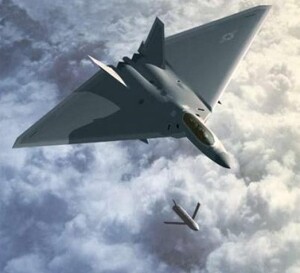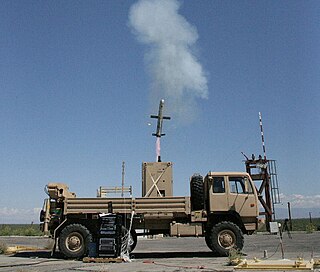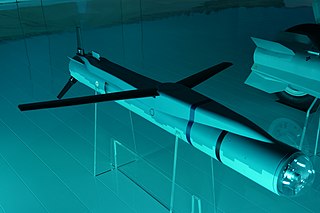Related Research Articles

The Rockwell B-1 Lancer is a supersonic variable-sweep wing, heavy bomber used by the United States Air Force. It has been nicknamed the "Bone". As of 2024, it is one of the United States Air Force's three strategic bombers, along with the B-2 Spirit and the B-52 Stratofortress. Its 75,000-pound (34,000 kg) payload is the heaviest of any U.S. bomber.

The Rockwell International Guided Bomb Unit 15 is an unpowered glide weapon used to destroy high-value enemy targets. It was designed for use with F-15E Strike Eagle, F-111 'Aardvark' and F-4 Phantom II aircraft. The GBU-15 has long-range maritime anti-ship capability with the B-52 Stratofortress.
The Joint Direct Attack Munition (JDAM) is a guidance kit that converts unguided bombs, or "dumb bombs", into all-weather precision-guided munitions (PGMs). JDAM-equipped bombs are guided by an integrated inertial guidance system coupled to a Global Positioning System (GPS) receiver, giving them a published range of up to 15 nautical miles (28 km). JDAM-equipped bombs range from 500 to 2,000 pounds. The JDAM's guidance system was jointly developed by the United States Air Force and United States Navy, hence the "joint" in JDAM. When installed on a bomb, the JDAM kit is given a GBU identifier, superseding the Mark 80 or BLU nomenclature of the bomb to which it is attached.

Stealth aircraft are designed to avoid detection using a variety of technologies that reduce reflection/emission of radar, infrared, visible light, radio frequency (RF) spectrum, and audio, all collectively known as stealth technology. The F-117 Nighthawk was the first operational aircraft explicitly designed around stealth technology. Other examples of stealth aircraft include the B-2 Spirit, the B-21 Raider, the F-22 Raptor, the F-35 Lightning II, the Chengdu J-20, and the Sukhoi Su-57.

The Boeing X-45 unmanned combat air vehicle is a concept demonstrator for a "next generation" of completely autonomous military aircraft, developed by Boeing's Phantom Works. Manufactured by Boeing Integrated Defense Systems, the X-45 was a part of DARPA's J-UCAS project.

The Dassault Mirage 2000N is a variant of the Mirage 2000 designed for nuclear strike. It formed the core of the French air-based strategic nuclear deterrent. The Mirage 2000D is its conventional attack counterpart. Although it looks like a Mirage 2000 trainer, it was actually used as a fighter-attack aircraft.

Brimstone is a ground or air-launched ground attack missile developed by MBDA UK for the UK's Royal Air Force. It was originally intended for "fire-and-forget" use against mass formations of enemy armour, using a millimetre wave (mmW) active radar homing seeker to ensure accuracy even against moving targets. Experience in Afghanistan led to the addition of laser guidance in the dual-mode Brimstone missile, allowing a "spotter" to pick out specific and the highest priority targets, particularly useful to minimise collateral damage when friendly forces or civilians were in the area. The tandem shaped-charge warhead is much more effective against modern tanks than older similar weapons such as the AGM-65G Maverick missile. Three Brimstones are carried on a launcher that occupies a single weapon station, allowing a single aircraft to carry many missiles.

The Lockheed Martin FB-22 was a proposed supersonic stealth bomber aircraft for the United States Air Force, derived from the F-22 Raptor air superiority fighter. Lockheed Martin proposed its design in the early 2000s with support from certain Air Force leaders as an interim "regional bomber" to complement the aging U.S. strategic bomber fleet, whose replacement was planned to enter service after 2037. The FB-22 was to leverage much of the design work and components from the F-22 to reduce development costs.

The AGM-62 Walleye is a television-guided glide bomb which was produced by Martin Marietta and used by the United States Armed Forces from the 1960s-1990s. The Walleye I had a 825 lb (374 kg) high-explosive warhead; the later Walleye II "Fat Albert" version had a 2000 lb warhead and the ability to replace that with a W72 nuclear warhead.

The "SPICE" is an Israeli-developed, EO/GPS- guidance kit used for converting air-droppable unguided bombs into precision-guided bombs.

The Non-Line of Sight Launch System (NLOS-LS) was a self-contained missile launcher system that was under development by NETFIRES LLC, a partnership between Lockheed Martin and Raytheon. Each Container Launch Unit (CLU) holds 15 missiles, and a self-locating networked communications system. CLUs can be linked for coordinated launching, with the missiles fired and controlled remotely via autonomous vertical launch. The weapon is roughly 2 metres tall.
The GBU-44/B Viper Strike glide bomb was a GPS-aided laser-guided variant of the Northrop Grumman Brilliant Anti-Tank (BAT) munition which originally had a combination acoustic and infrared homing seeker. The system was initially intended for use from UAVs, and it was also integrated with the Lockheed AC-130 gunship, giving that aircraft a precision stand-off capability. The Viper Strike design is now owned by MBDA.

A precision-guided munition (PGM), also called a smart weapon, smart munition, or smart bomb, is a guided munition intended to hit a specific target, to minimize collateral damage and increase lethality against intended targets. During the Persian Gulf War guided munitions accounted for only 9% of weapons fired, but accounted for 75% of all successful hits. Despite guided weapons generally being used on more difficult targets, they were still 35 times more likely to destroy their targets per weapon dropped.

The GBU-53/B StormBreaker, previously known as the Small Diameter Bomb II, is an American air-launched, precision-guided glide bomb.

The GBU-39/B Small Diameter Bomb (SDB) is a 250-pound (110 kg) precision-guided glide bomb that is intended to allow aircraft to carry a greater number of smaller, more accurate bombs. Most US Air Force aircraft will be able to carry a pack of four SDBs in place of a single 2,000-pound (910 kg) Mark 84 bomb. It first entered service in 2006. The Ground Launched Small Diameter Bomb (GLSDB) was later developed to enable the SDB to be launched from a variety of ground launchers and configurations.

Aircraft ordnance or ordnance is any expendable weaponry used by military aircraft. The term is often used when describing the payload of air-to-ground weaponry that can be carried by the aircraft or the weight that has been dropped in combat. Aircraft ordnance also includes air-to-air, anti-ship and anti-submarine weapons.

Sudarshan is an Indian laser-guided bomb kit, developed by Aeronautical Development Establishment (ADE), a DRDO lab with technological support from another DRDO lab Instruments Research and Development Establishment (IRDE), for the Indian Air Force (IAF).

SPEAR is a family of air-launched effectors under development by MBDA UK for the Royal Air Force's Select Precision Effects At Range (SPEAR) Capability 3, or SPEAR 3 programme, from which the system also derives its name. The SPEAR family currently consists of two variants: SPEAR, a 100kg class air-to-surface cruise missile; and SPEAR-EW, an electronic warfare variant for stand-in jamming or for use as a decoy.
The DRDO Smart Anti-Airfield Weapon (SAAW) is a long-range precision-guided anti-airfield weapon developed by India's Defence Research and Development Organisation (DRDO). It is designed to be capable of engaging ground targets with high precision up to a range of 100 kilometres (62 mi).
The High Speed Low Drag (HSLD) bomb is a family of new generation short range air-dropped precision-guided munition that is currently being developed by India's Defence Research and Development Organisation (DRDO). This general-purpose bomb is made for the Indian Air Force (IAF) and can be used against the destruction of strategic high value enemy infrastructure from stand-off distances. HSLD is comparable to Mark 80 series of bombs used by United States Air Force (USAF).
References
- ↑ Joint Test and Evaluation. "Joint Command and Control for Net-enabled Weapons" (PDF). Defense Technical Information Center. Archived from the original (PDF) on October 1, 2007. Retrieved 27 August 2012.
- ↑ "World's First Net-enabled Weapon Completes Developmental Testing". Baynet.com. 25 January 2012. Archived from the original on 28 January 2012. Retrieved 27 August 2012.
- 1 2 Sanders, Keith. "Network Enabled Strike" (PDF). National Defence Industrial Association.
- ↑ Koudelka, Benjamin. "Network-enabled Precision Guided Munitions" (PDF). Air University. Archived from the original (PDF) on February 21, 2007. Retrieved August 27, 2012.
- ↑ Taylor, Ron (December 2004). "Net-Enabled Weapons". Intercom. 45 (12): 11. Retrieved 27 August 2012.
- ↑ Rutledge, Linda. "Weapons Datalink Network Advanced Concept Technology Demonstration" . Retrieved 27 August 2012.
- ↑ Staff Writers. "Small Diameter Bomb II finds, hits moving target". Space War. Retrieved 27 August 2012.